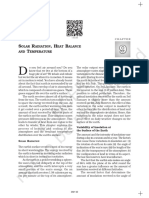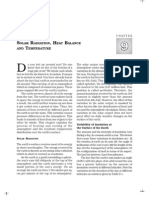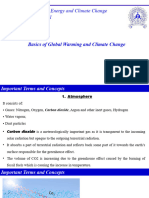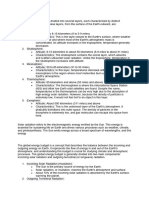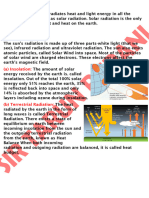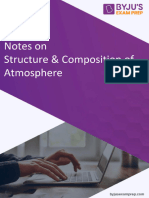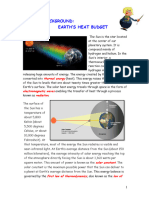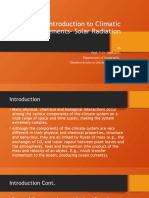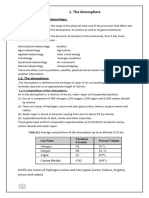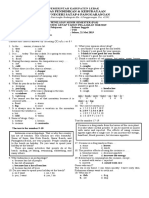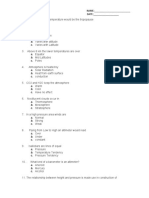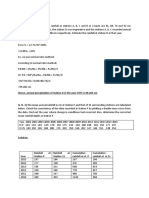Chapter - 9: Solar Radiation, Heat Balance and Temperature
Chapter - 9: Solar Radiation, Heat Balance and Temperature
Uploaded by
Jagatraj SahuCopyright:
Available Formats
Chapter - 9: Solar Radiation, Heat Balance and Temperature
Chapter - 9: Solar Radiation, Heat Balance and Temperature
Uploaded by
Jagatraj SahuOriginal Title
Copyright
Available Formats
Share this document
Did you find this document useful?
Is this content inappropriate?
Copyright:
Available Formats
Chapter - 9: Solar Radiation, Heat Balance and Temperature
Chapter - 9: Solar Radiation, Heat Balance and Temperature
Uploaded by
Jagatraj SahuCopyright:
Available Formats
CHAPTER -9 SOLAR RADIATION, HEAT BALANCE AND TEMPERATURE
This chapter deals with
Solar radiation, variability of insolation at the surface of the earth heating and cooling of
atmosphere, terrestrial radiation ,heat budget of the planet earth, latitudinal variation in net
radiation balance, temperature, factors influencing the temperature (such as the latitude,
altitude, distance from the sea air mass ocean currents) distribution of temperature, isotherm.
Define insolation.
The earth‘s surface receives most of its energy in short wavelengths. The energy received by the
earth is known as incoming solar radiation which in short is termed as insolation.
Which factor is responsible for the varied distribution of energy?
As the earth is a Geoid resembling a sphere, the sun‘s rays fall obliquely at the top of the
atmosphere and the earth intercepts a very small portion of the sun‘s energy.
What is the average amount of energy received by the earth?
On an average the earth receives 1.94 calories per sq. cm per minute at the top of its atmosphere.
Give the reasons why it is summer when earth is far away from the sun and winter when it is nearest
to the Sun.
The solar output received at the top of the atmosphere varies slightly in a year due to the variations
in the distance between the earth and the sun. During its revolution around the sun, the earth is
farthest from the sun (152 million km) on 4th July. This position of the earth is called aphelion. On
3rd January, the earth is the nearest to the sun (147 million km). This position is called perihelion.
Therefore, the annual insolation received by the earth on 3 rd January is slightly more than the
amount received on 4th July. However, the effect of this variation in the solar output is masked by
other factors like the distribution of land and sea and the atmospheric circulation. Hence, this
variation in the solar output does not have
great effect on daily weather changes on the surface of the earth.
Variability of Insolation at the Surface of the Earth
The amount and the intensity of insolation vary during a day, in a season and in a year. The factors
that cause these variations in insolation are
(i) the rotation of earth on its axis;
(ii) the angle of inclination of the sun‘s rays;
(iii) the length of the day;
(iv) the transparency of the atmosphere;
(v) the configuration of land in terms of its aspect.
The last two however, have less influence. The fact that the earth‘s axis makes an angle of 66_ with
the plane of its orbit round the sun has a greater influence on the amount of insolation received at
different latitudes.
Note: The variations in the duration of the day at different latitudes on solstices are given in the
Table below.
The second factor that determines the amount of insolation received is the angle of
inclination of the rays. This depends on the latitude of a place. The higher the latitude the less is
the angle they make with the surface of the earth resulting in slant sunrays. The area covered by
vertical rays is always less than that covered by the slant rays. If more area is covered, the energy
gets distributed and the net energy received
per unit area decreases. Moreover, the slant rays are required to pass through greater depth of the
atmosphere resulting in more absorption, scattering and diffusion.
The incoming radiation is not fully reached to the earth surface. Why ?
1. The atmosphere is largely transparent to short wave solar radiation. The incoming solar radiation
passes through the atmosphere before striking the earth‘s surface.
2. Within the troposphere water vapor, ozone and other gases absorb much of the near infrared
radiation.
3. Very small-suspended particles in the troposphere scatter visible spectrum both to the space and
towards the earth surface.
Material Downloaded From SUPERCOP 1/4
4. This process adds colour to the sky.
5. The red colour of the rising and the setting sun and the blue colour of the sky are the result of
scattering of light within the atmosphere.
What is the average distribution of insolation on the surface ?Give the reasons for such
variation.
Spatial Distribution of Insolation on the Earth’s Surface
The insolation received at the surface varies
from about 320 Watt/m in the tropics to about 70 Watt/min the poles. Maximum insolation is
received over the subtropical deserts, where the cloudiness is the least. Equator receives
comparatively less insolation than the tropics. Generally, at the same latitude the insolation is more
over the continent than over the oceans. In winter, the middle and higher latitudes receive less
radiation than in summer.
HEATING AND COOLING OF ATMOSPHERE
Name the ways of heating the atmosphere.
1. Radiation 2. Conduction 3. Advection 4. convection
1. Horizontal movement of the air is relatively more important than the vertical movement.
2. In middle latitudes, most of diurnal (day and night) variation in daily weather are caused by
advection alone.
3. In tropical regions particularly in northern India during summer season local winds called ‗loo‘ is
the outcome of advection process.
Terrestrial Radiation
1. The insolation received by the earth is in shortwaves forms and heats up its surface.
2. The earth after being heated itself becomes a radiating body and it radiates energy to the
atmosphere in long wave form.
3. This energy heats up the atmosphere from below.
4. This process is known as terrestrial radiation.
5. The long wave radiation is absorbed by the atmospheric gases particularly by carbon dioxide and
the other green house gases. Thus, the atmosphere is indirectly heated by the earth‘s radiation.
The atmosphere in turn radiates and transmits heat to the space. Finally the amount of heat
received from the sun is returned to space, thereby maintaining constant temperature at the earth‘s
surface and in the atmosphere.
With the help of a diagram explain the Heat Budget of the Planet Earth.
INCOMING SOLAR RDIATION
1. Figure 9.2 depicts the heat budget of the planet earth. The earth as a whole does
Not accumulate or loose heat. It maintains its temperature.
2. This can happen only if the amount of heat received in the form of insolation
equals the amount lost by the earth through terrestrial radiation.
3. Consider that the insolation received at the top of the atmosphere is 100 percent.
4. While passing through the atmosphere some amount of energy is reflected,
scattered and absorbed.
5. Only the remaining part reaches the earth surface.
6. Roughly 35 units are reflected back to space even before reaching the earth‘s surface.
7. Of these, 27 units are reflected back from the top of the clouds
Material Downloaded From SUPERCOP 2/4
8. Only 2 units from the snow and ice-covered areas of the earth.
9. The remaining 65 units are absorbed,
10. 14 units within the atmosphere and 51 units by the earth‘s surface.
TERRESTRIAL RADIATION
1. The earth radiates back 51 units in the form of terrestrial radiation.
2. 17 units are radiated to space directly
3. the remaining 34 units are absorbed by the atmosphere
4.6 units absorbed directly by the atmosphere,
5.9 units through convection and turbulence
6. 19 units through latent heat of condensation
7.48 units absorbed by the atmosphere(14 units from insolation +34 units from
terrestrial radiation) are also radiated back into space.
Thus, the total radiation returning from the earth and the atmosphere
respectively is 17+48=65 units which balance the total of 65 units received from
the sun. This is termed the heat budget or heat balance of the earth.
This explains, why the earth neither warms up nor cools down despite the huge transfer of heat that
takes place.
What do you mean by ‗Albedo‘?
The reflected amount of radiation is called the albedo of the earth.
Variation in the Net Heat Budget at the Earth’s Surface
As explained earlier, there are variations in the amount of radiation received at the earth‘s surface.
Some part of the earth has surplus radiation balance while the other part has deficit.
Figure 9.3 depicts the latitudinal variation
in the net radiation balance of the earth
the atmosphere system.
The figure shows that there is a surplus of
net radiation balance between 40 degrees
north and south and the regions near the
poles have a deficit.
The surplus heat energy from the tropics is
redistributed pole wards and as a result the
tropics do not get progressively heated up
due to the accumulation of excess heat or
the high latitudes get permanently frozen
due to excess deficit.
WHAT IS THE DIFFERENCE BETWEEN HEAT AND TEMPERATURE
Temperature
The interaction of insolation with the atmosphere and the earth‘s surface creates
heat which is measured in terms of temperature.
While heat represents the molecular movement of particles comprising a substance, the
temperature is the measurement in degrees of how hot (or cold) a thing (or a
place) is.
Factors Controlling Temperature Distribution
The temperature of air at any place is influenced by
(i) the latitude of the place;
(ii) the altitude of the place;
(iii) distance from the sea, the air mass circulation;
(IV) the presence of warm and cold ocean currents; (v) local aspects.
1.The latitude : The temperature of a place depends on the insolation received. It has been
explained earlier that the insolation varies
according to the latitude hence the temperature
also varies accordingly.
2.The altitude : The atmosphere is indirectly
heated by terrestrial radiation from below.
Therefore, the places near the sea-level record
higher temperature than the places situated at
higher elevations. In other words, the temperature
generally decreases with increasing height. The
rate of decrease of temperature with height is
Material Downloaded From SUPERCOP 3/4
termed as the normal lapse rate. It is 6.5°C per 1,000 m.
Distance from the sea: Another factor that influences the temperature is the location of a place
with respect to the sea. Compared to land, the sea gets heated slowly and loses heat slowly. Land
heats up and cools down quickly. Therefore, the variation in temperature over the sea is less
compared to land. The places situated near the sea come under the moderating influence of the sea
and land breezes which moderate the temperature.
Air-mass: Like the land and sea breezes, the passage of air masses also affects the temperature.
The places, which come under the influence of warm air-masses experience higher temperature and
the places that come under the influence of cold air masses experience low temperature.
Ocean currents
Similarly, the places located on the coast where the warm ocean currents flow record higher
temperature than the places located on the coast where the cold currents flow.
Isotherms are lines joining places having equal
temperature.
Fig no. 9.4 (a) distribution of surface
temperature in the month of january
Figure 9.4 (a) and (b) show the distribution of
surface air temperature in the month of January
and July.
1. In general the effect of the latitude on
temperature is well pronounced on the map,
2. the isotherms are generally parallel to the
latitude.
3. The deviation from this general trend is more pronounced in January than in July, especially in
the northern hemisphere.
4. In the northern hemisphere the land surface area is much larger than in the southern hemisphere.
5 .Hence, the effects of land mass and the ocean currents are well pronounced.
In January the isotherms deviate to the north over the ocean and to the south over the continent.
This can be seen on the North Atlantic Ocean.
INVERSION OF TEMPERATURE
Normally, temperature decreases with increase in elevation. It is called normal lapse rate. At times,
the situations is reversed and the normal lapse rate is inverted. It is called Inversion of temperature.
Inversion is usually of short duration but quite common nonetheless. A long winter night with clear
skies and still air is ideal situation for inversion. The heat of the day is radiated off during the night,
and by early morning hours, the earth is cooler than the air above.
Material Downloaded From SUPERCOP 4/4
You might also like
- Wind Load On Cable TraysDocument10 pagesWind Load On Cable TraysAaron EasleyNo ratings yet
- O Level Geography Notes Physical NotesDocument157 pagesO Level Geography Notes Physical NotesBrendon T100% (3)
- Activity Sheet On TyphoonDocument4 pagesActivity Sheet On TyphoonArgyll Paguibitan100% (9)
- Green House EffectDocument8 pagesGreen House EffectChitrangada Chakraborty100% (1)
- Kegy 208Document9 pagesKegy 208nandanpancholi2000No ratings yet
- Class 11 Chap 8Document9 pagesClass 11 Chap 8Vishal Deep SarangalNo ratings yet
- S R, H B T: Olar Adiation EAT Alance AND EmperatureDocument9 pagesS R, H B T: Olar Adiation EAT Alance AND EmperatureLaila KhattakNo ratings yet
- CH 9Document9 pagesCH 9anil.gelra5140No ratings yet
- Insolation and Heat Balance of The EarthDocument10 pagesInsolation and Heat Balance of The EarthDevraj H SNo ratings yet
- Solar Radiation, Heat Balance and Temperature QS and AnsDocument3 pagesSolar Radiation, Heat Balance and Temperature QS and AnsRounak ChatterjeeNo ratings yet
- Solar RadiationDocument9 pagesSolar Radiationniwey77718No ratings yet
- CH 10Document18 pagesCH 10Ankush VermaNo ratings yet
- CST 206 Lecture TemperatureDocument7 pagesCST 206 Lecture Temperaturejaymike5423No ratings yet
- The Passage of Solar Radiation Through The AtmosphereDocument2 pagesThe Passage of Solar Radiation Through The AtmosphereSam SelinNo ratings yet
- 1.1basics of Global Warming and Climate ChangeDocument16 pages1.1basics of Global Warming and Climate ChangeOwais AhmadNo ratings yet
- Module 1 & 2 NotesDocument36 pagesModule 1 & 2 NotesMartini25No ratings yet
- Solar and Solar Radiation - Air Temperature-Atmospheric PressureDocument21 pagesSolar and Solar Radiation - Air Temperature-Atmospheric PressureMarjorie TacordaNo ratings yet
- Solar RadiationDocument4 pagesSolar RadiationVikram DasNo ratings yet
- CH 3 Atmospheric TemperatureDocument5 pagesCH 3 Atmospheric TemperatureRonnith NandyNo ratings yet
- Ak HWDocument4 pagesAk HWakbarshahbasaratNo ratings yet
- Climate WorksheetDocument7 pagesClimate WorksheetgarciamNo ratings yet
- Heat Budget - 12Document9 pagesHeat Budget - 12skinnysandip18No ratings yet
- Energy Balance Lecture 4...............................Document35 pagesEnergy Balance Lecture 4...............................Godfrey MafuluNo ratings yet
- INSOLATIONDocument6 pagesINSOLATIONAnupam RoyNo ratings yet
- AtmosphereDocument12 pagesAtmospherelovemhiz431No ratings yet
- Earth Heat Budget SystemDocument19 pagesEarth Heat Budget SystemHuma r.no:7 Bs zoology VllNo ratings yet
- InsolationDocument4 pagesInsolationAnubhav YadavNo ratings yet
- Structure Composition of Atmosphere Water in The Atmosphere 16Document15 pagesStructure Composition of Atmosphere Water in The Atmosphere 16aarliokumarNo ratings yet
- Earths Climate Past and Future 3rd Edition Ruddiman Solutions ManualDocument3 pagesEarths Climate Past and Future 3rd Edition Ruddiman Solutions Manualjessicaramseymxpqrcbgjt100% (11)
- Earth Annual Energy BalanceDocument5 pagesEarth Annual Energy BalanceJuila jean ManagaytayNo ratings yet
- Sudarshangurjar-CoDocument7 pagesSudarshangurjar-Cotestacount3258No ratings yet
- Fators Affecting Climate (Global Climatic Factors)Document28 pagesFators Affecting Climate (Global Climatic Factors)Bishal RanaNo ratings yet
- Insolation & TemperatureDocument6 pagesInsolation & TemperatureAswin ANo ratings yet
- chaper 9Document8 pageschaper 9vashuok081No ratings yet
- A Simple Guide To Energy Budgets: Number 167 WWW - Curriculum-Press - Co.ukDocument4 pagesA Simple Guide To Energy Budgets: Number 167 WWW - Curriculum-Press - Co.ukKamaria ThomasNo ratings yet
- Insolation, Atmospheric Temperature and Heat Budget of The EarthDocument31 pagesInsolation, Atmospheric Temperature and Heat Budget of The Earthbirudulavinod1100% (1)
- Temperature: Objective: - Desired Learning OutcomesDocument12 pagesTemperature: Objective: - Desired Learning OutcomesSyeda FarvaNo ratings yet
- GRP 132 Lecture Note 3Document9 pagesGRP 132 Lecture Note 3Adams TemitopeNo ratings yet
- Energy Balance and The Greenhouse EffectDocument6 pagesEnergy Balance and The Greenhouse Effectsteph wallNo ratings yet
- DTW.12 InsolationDocument7 pagesDTW.12 InsolationniroopswaradNo ratings yet
- Biophysical Environments: The AtmosphereDocument5 pagesBiophysical Environments: The AtmosphereAnanya UppalNo ratings yet
- Climate - The Given ConditionsDocument35 pagesClimate - The Given ConditionsKAMAL S. TOMARNo ratings yet
- Climate Change and Its Effects - Who's Taking Charge?Document104 pagesClimate Change and Its Effects - Who's Taking Charge?RAYMOND BRIAN TORRESNo ratings yet
- Chapter 2 - Physical Processes On EarthDocument65 pagesChapter 2 - Physical Processes On EarthClydeNo ratings yet
- Module 8 - Atmosphere Structure and TemperatureDocument3 pagesModule 8 - Atmosphere Structure and TemperaturejuliaroxasNo ratings yet
- InsloationDocument7 pagesInsloationNova ChronoNo ratings yet
- Apes 3e TRM 04 Lecture Slide 4Document70 pagesApes 3e TRM 04 Lecture Slide 4dmqrtx8x8kNo ratings yet
- TBI Earths Radiative Heat BudgetDocument5 pagesTBI Earths Radiative Heat Budgetcoderb1010No ratings yet
- Chapter 7: Weather Hazards: Learning Outcomes Essential QuestionsDocument60 pagesChapter 7: Weather Hazards: Learning Outcomes Essential Questionsapi-285089552No ratings yet
- Blackbody TemperatureDocument37 pagesBlackbody TemperatureDavid PristashNo ratings yet
- Geography Module 1 NotesDocument7 pagesGeography Module 1 NotesSerena SulawammotNo ratings yet
- Climatology 1Document11 pagesClimatology 1Ritu RaniNo ratings yet
- Watts Solar Power PhotosynthesisDocument19 pagesWatts Solar Power Photosynthesispradeep1924No ratings yet
- Module 1 (CCS)Document47 pagesModule 1 (CCS)nithya.a.sNo ratings yet
- Unit 2: Micro EnvironmentDocument8 pagesUnit 2: Micro EnvironmentHasini KadaruNo ratings yet
- GPY 203 - Introduction To Climatic Elements & Solar Radiation-1Document43 pagesGPY 203 - Introduction To Climatic Elements & Solar Radiation-1adeyemiomolola1207No ratings yet
- 1.solar EnergyDocument70 pages1.solar EnergyRohan JindalNo ratings yet
- Chapt-34 WEATHER ELEMENTSDocument22 pagesChapt-34 WEATHER ELEMENTSWedesu EyobNo ratings yet
- Unit_1_Chap_2Document18 pagesUnit_1_Chap_2suyog.gambhireNo ratings yet
- Meteorology 461Document31 pagesMeteorology 461fareselhashimNo ratings yet
- Questions and Answers about: Planet EarthFrom EverandQuestions and Answers about: Planet EarthRating: 3 out of 5 stars3/5 (1)
- SECOND QUARTER - Earth ScienceDocument8 pagesSECOND QUARTER - Earth ScienceLea SantillanNo ratings yet
- Physical Features of India Class 9Document3 pagesPhysical Features of India Class 9Lakshya Classes, MAHUA LC,M100% (2)
- National Football League Game Summary: Minnesota Vikings at New Orleans SaintsDocument14 pagesNational Football League Game Summary: Minnesota Vikings at New Orleans SaintswstNo ratings yet
- Xpower VRF SeriesDocument11 pagesXpower VRF SeriesMelissa MendozaNo ratings yet
- HEALTH 4 L1 Id 529fe5ae18edDocument11 pagesHEALTH 4 L1 Id 529fe5ae18edGretcel Gret CelisNo ratings yet
- Soal Uas B.inggris Kls ViiiDocument2 pagesSoal Uas B.inggris Kls ViiiHard DianNo ratings yet
- Challenger Sweeper PDFDocument33 pagesChallenger Sweeper PDFrahulNo ratings yet
- Assignment No 1 With AnswersDocument19 pagesAssignment No 1 With AnswersKunal GujarathiNo ratings yet
- Aerographer's Mate 1 & CDocument272 pagesAerographer's Mate 1 & CBob Kowalski100% (1)
- Ap Grade10Document9 pagesAp Grade10Moscardon Sobrevega DennisNo ratings yet
- Trinidad Guardian - 07.10.22Document48 pagesTrinidad Guardian - 07.10.22D-TECH CONTRACTINGNo ratings yet
- Handout - Education in EmergenciesDocument31 pagesHandout - Education in EmergenciesFortunatoNo ratings yet
- Second Periodical Test ScienceDocument2 pagesSecond Periodical Test ScienceMelodina AcainNo ratings yet
- Anh SơnDocument4 pagesAnh Sơnphuonggchi74No ratings yet
- Technical Specification For PLS CADDDocument31 pagesTechnical Specification For PLS CADDMohammad Mynul IslamNo ratings yet
- Met I C Joshi, FullDocument6 pagesMet I C Joshi, FullTushar MantriNo ratings yet
- History of ElectricityDocument21 pagesHistory of ElectricityAnbu Kaviraj SubramanianNo ratings yet
- V SST WEATHER AND CLIMATE LESSON-1 N 2, 2022Document46 pagesV SST WEATHER AND CLIMATE LESSON-1 N 2, 2022Seher ImtiazNo ratings yet
- Snow Joe Ultra 21'' 14amp ManualDocument20 pagesSnow Joe Ultra 21'' 14amp ManualHugues EmondNo ratings yet
- Scientific Tools For Assessing Landslides and SinkholesDocument17 pagesScientific Tools For Assessing Landslides and Sinkholesjoy macalintalNo ratings yet
- đề 2Document5 pagesđề 2Hồ Gia NhiNo ratings yet
- Wind DesignDocument1 pageWind Design9886013865aNo ratings yet
- Hydrology Assignment-1Document9 pagesHydrology Assignment-1Arun BhattaNo ratings yet
- SIP Project Monitoring ToolDocument5 pagesSIP Project Monitoring ToolaizaNo ratings yet
- Rainfall InducedDocument29 pagesRainfall InducedAbrivylle CeriseNo ratings yet
- Climatology Presentation 1Document30 pagesClimatology Presentation 1Janardhan Rao MalakapalliNo ratings yet
- Final LP in Science 4Document7 pagesFinal LP in Science 4Danica AlejandroNo ratings yet
- Sisson EIA July2013 Section 8-16 Effects of The Environment PDFDocument20 pagesSisson EIA July2013 Section 8-16 Effects of The Environment PDFJeetendra TulsaniNo ratings yet






